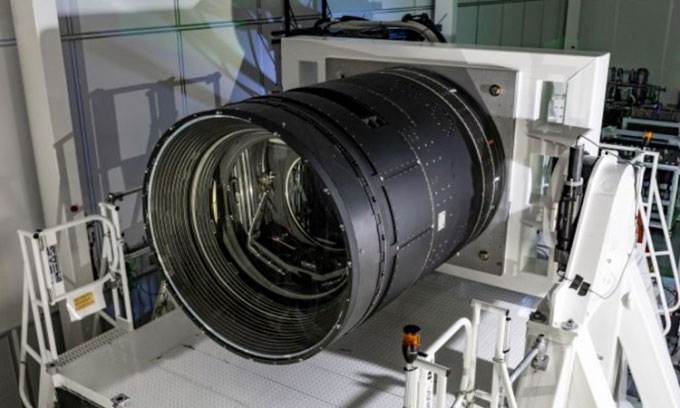World's largest digital camera ready for action
The world's largest digital camera, perched atop a mountain in northern Chile, will capture images of the entire night sky in stunning detail and reveal some of the mysteries of the universe.
Located at the Vera C. Rubin Observatory, a new telescope nearing completion on Cerro Pachón, a 2,682-meter-high mountain about 300 miles north of the Chilean capital Santiago, the camera has a resolution of 3,200 megapixels, equivalent to the number of pixels in 300 cell phones. Each image taken by the camera will cover an area of sky as large as 40 full moons, CNN reported on October 23.

The world's largest digital camera is located at the Vera C. Rubin Observatory. (Photo: Jacqueline Ramseyer Orrell/SLAC)
Every three nights, the telescope will photograph the entire visible sky, creating thousands of images that will allow astronomers to see anything that moves or changes in light. Vera Rubin is expected to discover about 17 billion stars and 20 billion galaxies that we have never seen before. Clare Higgs, a specialist at the observatory, said the telescope will survey the night sky for a decade, taking 1,000 images each night.
Construction began in 2015 and the telescope is named after pioneering American astronomer Vera Rubin, who first confirmed the existence of dark matter, a mysterious compound that makes up most of the matter in the universe but has never been observed. The project began in the early 2000s with private donations, including from billionaires Charles Simonyi and Bill Gates. It later received additional funding from the US Department of Energy's Office of Science and the US National Science Foundation.
Although the Vera C. Rubin Observatory is an American observatory, it is located in the Chilean Andes along with several other telescopes for several reasons. Optical telescopes require high, dark, and dry areas to avoid light pollution and air humidity that can reduce the sensitivity of the instrument, Higgs said. In addition, the quality of the night sky in Chile is excellent. The observatory is remote, but not so remote that data collection is problematic. The observatory is currently in the final stages of construction and is expected to be operational in 2025. After several months of testing, the facility will make its first observations in late 2025.
The Vera C. Rubin Observatory's primary mission is called the Legacy Survey of Space and Time (LSST). This 10-year survey essentially allows researchers to create a movie of the southern sky over a decade. The camera takes a picture every 30 seconds, generating 20 terabytes of data every 24 hours. When complete, the survey will have produced more than 60 million terabytes of raw data.
But each image takes just 60 seconds to travel from Chile to California, where AI and algorithms will analyze the data first, looking for any changes or moving objects, and alerting if they detect anything. The data will be shared with a group of astronomers each year. Every two years, each dataset will be shared publicly for the global scientific community to study.
The data will serve four main research areas: creating a catalogue of the solar system, including discovering new celestial bodies, even a hidden ninth planet, mapping the entire galaxy, discovering a special type of object called a "transient" that changes position and brightness over time, and understanding the nature of dark matter.
- The journey to transport the world's largest camera to the top of the mountain
- Camera based on insect eyes
- The world's largest digital camera
- The world's largest digital camera helps uncover the secrets of dark matter
- Turn a 50-year-old film camera into a digital camera
- America is building the world's largest camera
- The world's most powerful digital camera hunts for dark energy
- Panasonic introduces new digital cameras
- Canon produces fully automatic cameras
- The world's largest camera was created ... just to capture a panorama of a train
- The 3.2 billion pixel camera in Chile is about to observe the universe
- Fire detection camera
 The US company is about to build a supersonic passenger plane of 6,000km / h
The US company is about to build a supersonic passenger plane of 6,000km / h Japan develops avatar robot as in fiction film
Japan develops avatar robot as in fiction film Australia tested the world's first mango picking robot
Australia tested the world's first mango picking robot America develops technology to separate water from animal waste
America develops technology to separate water from animal waste